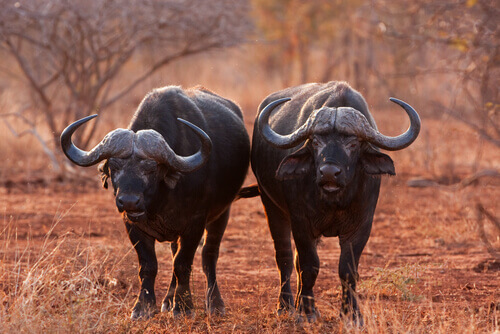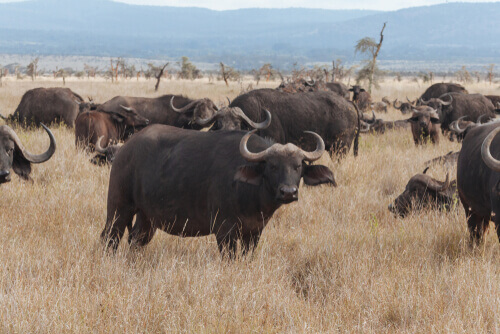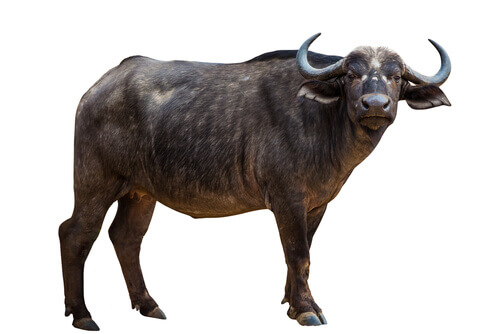Characteristics and Types of Buffaloes: Beauty and Power Combined

The origin of the buffaloes dates back to around 4,500 years BC in the region where the countries of Pakistan and India are currently located. This mammal is quite similar to the common bull although it doesn’t have a dewlap. This species has now progressively moved to the other continents and inhabits many areas there. Find out about the different types of buffaloes in this article.
Types of buffaloes
There are three types of buffaloes, according to the place they inhabit and the way we exploit them.
- The Asian buffalo (water buffalo) originated in India and was domesticated in South Asia. Farmers use them for agricultural purposes and their meat and milk are also quite popular there. Buffalo milk is the second most popular in the world and contains a higher percentage and quality of fat compared to other cattle. Similarly, buffalo meat is juicier and richer in minerals than beef.
- The African buffalo is the strongest of the species; the males can weigh up to 2500 pounds. Unlike the Asian one, this one isn’t that friendly and humans haven’t been able to domesticate it.
- The American buffalo or bison (Bison bison). Located in the northern plans of Mexico and within the territory of the United States and Canada. It exhibits a peculiar hump that distinguishes it from other buffaloes.
Characteristics of buffalos
The males can reach about 6 feet high at the withers and weigh about 1650 pounds. Buffaloes usually live between 18 and 20 years; however, this average could extend to 30 in captivity.
Buffaloes can both be devoid of hair or have short rigid hair with all colors between black and white. Also, their horns are flattened and curved backward.
As for their preferred habitat and environment, the buffalo has a preference for waterlogged or swampy areas. They partially dive there and walk on the bottom without difficulty thanks to their wide hooves, which keep them from sinking in the mud.
While some of them could be dangerous to humans in their wild environment, domesticated buffaloes are actually docile animals. This is the case with the Asian buffalo.
This creature inhabits all five continents but the Asian population is the largest. In fact, there are about 141 million domestic buffaloes on this continent alone and people have been exploiting them since ancient times to pull the plow in their swampy lands.

Buffaloes move in small herds in the wild, and their natural predators are the tiger, crocodile, and the wild Asian dog. They’re well-known for their stampedes and will run over anything in their path when they feel like they have to flee for any reason — it includes any fellow buffaloes who can’t keep up.
Buffalo behavior
Buffaloes are characterized by being very social and in nature they live in herds. Groups usually stay compact and walk in circles to watch out for predators. In addition, they emit various types of vocalizations that allow them to communicate and prevent members from getting lost.
Most buffaloes are passive and fearful, so when they detect a predator they try to flee at full speed. However, the African species is characterized by being aggressive and more reactive. Because of this, they tend to react aggressively and will not hesitate to attack their opponents.
Buffalo feeding
These mammals are herbivores and take the opportunity to consume the grass and grass in their habitat. In the case of Asian specimens that frequent areas with water, they also tend to eat aquatic plants. Of course, they need to eat about 30 kilos of food to maintain their huge body.
Domestic and wild buffaloes
According to the utility that the specimen has for man, two types of buffalo can be identified: the domestic and the wild. As their name implies, domestic buffaloes are characterized by living in harmony as part of the herd, while wild ones tend to be a bit more aggressive and live without problems in the wild.
In the case of the domestic buffalo, in addition to its use in the field, it has also gained a place in the productive market for its meat and milk. In fact, the female is the second largest producer of milk in the world, which contains a higher percentage and quality of fat compared to other bovines. On the other hand, buffalo meat is more juicy, delicious and rich in minerals than beef.
As can be guessed, most of the wild specimens can be domesticated regardless of the species in question, with the exception of African specimens. The African buffalo is the strongest of all species; in the case of males, it can weigh up to 1,100 kg (2400 pounds). Unlike the Asian or the bison, this buffalo has a very bad character and is almost impossible to tame.

Differences between bison and buffaloes
Most people think bison are a type of buffalo but the animals that inhabit the USA aren’t so. Unlike the latter, bison have sharper shorter horns, the same that they use for self-defense. They’re extremely aggressive when threatened.
In addition, the North American animals have a big hump, a dark long mane, and a thick beard that reaches their thorax. They can weigh between 1700 and 2000 pounds and measure almost 13 feet.
Bison live in herds but these are hard to find these days. This is because humans have been hunting them for their skin and meat for decades. They’re currently an endangered species.
Humans value bison’s skin over many others because it’s tougher than that of other cattle and so the products made with it are high quality. Thus, bison leather goods such as gloves and sandals are in high demand.
The few specimens that have survived humans, their main predator, inhabit grasslands, open plains, woodland savannahs, and mountains and can tolerate altitudes of up to 13000 feet high.
All cited sources were thoroughly reviewed by our team to ensure their quality, reliability, currency, and validity. The bibliography of this article was considered reliable and of academic or scientific accuracy.
- Álvarez-Romero, J. y R. A. Medellín. (2005). Syncerus caffer. Vertebrados superiores exóticos en México: diversidad, distribución y efectos potenciales. Instituto de Ecología, Universidad Nacional Autónoma de México. Bases de datos SNIB-CONABIO. Proyecto U020. México. D.F
- Pérez, Y. A. (2007). El búfalo, una opción de la ganadería. REDVET. Revista electrónica de Veterinaria, 8(8), 1-23.
- SEMARNAT, (2018). Programa de Acción para la Conservación de la Especie Bisonte (Bison Bison), SEMARNAT/CONANP, México (Año de edición 2018).
